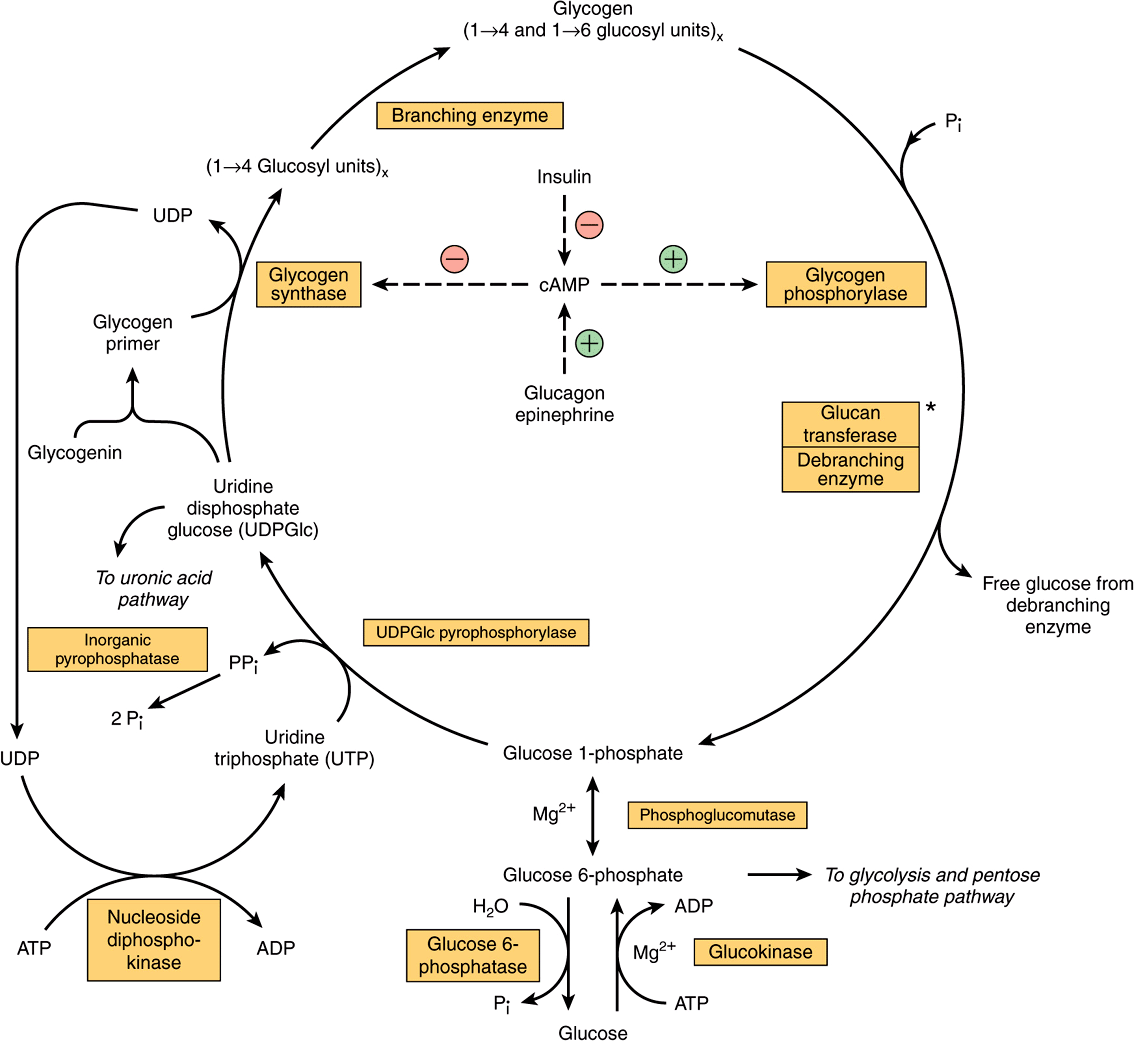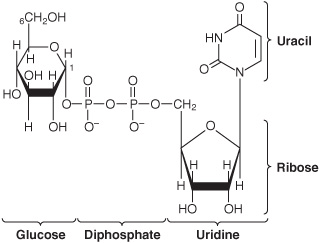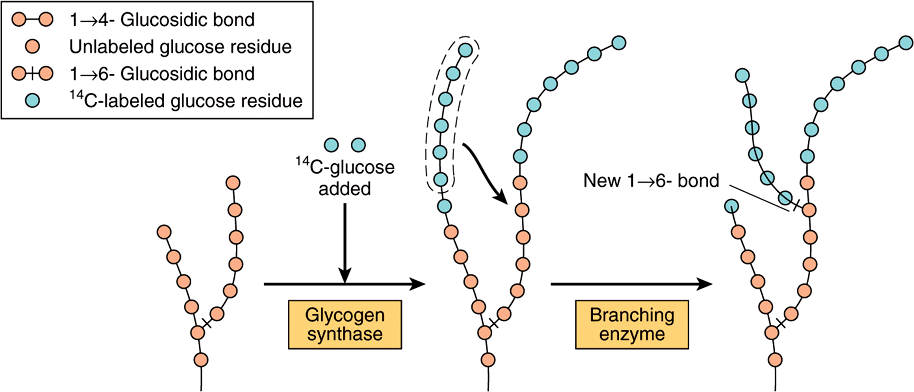19
Metabolism of Glycogen
David A. Bender, PhD & Peter A. Mayes, PhD, DSc
OBJECTIVES
After studying this chapter, you should be able to:
![]() Describe the structure of glycogen and its importance as a carbohydrate reserve.
Describe the structure of glycogen and its importance as a carbohydrate reserve.
![]() Describe the synthesis and breakdown of glycogen and how the processes are regulated in response to hormone action.
Describe the synthesis and breakdown of glycogen and how the processes are regulated in response to hormone action.
![]() Describe the various types of glycogen storage diseases.
Describe the various types of glycogen storage diseases.
BIOMEDICAL IMPORTANCE
Glycogen is the major storage carbohydrate in animals, corresponding to starch in plants; it is a branched polymer of α-D-glucose (Figure 14–13). It occurs mainly in liver and muscle, with modest amounts in the brain. Although the liver content of glycogen is greater than that of muscle, because the muscle mass of the body is considerably greater than that of the liver, about three-quarters of total body glycogen is in muscle (Table 19-1).
TABLE 19–1 Storage of Carbohydrate in a 70 kg Human Being
Muscle glycogen provides a readily available source of glucose 1-phosphate for glycolysis within the muscle itself. Liver glycogen functions to store and export glucose to maintain the blood glucose concentration in the fasting state. The liver concentration of glycogen is about 450 mM after a meal, falling to about 200 mM after an overnight fast; after 12-18 h of fasting, liver glycogen is almost totally depleted. Although muscle glycogen does not directly yield free glucose (because muscle lacks glucose 6-phosphatase), pyruvate formed by glycolysis in muscle can undergo transamination to alanine, which is exported from muscle and used for gluconeogenesis in the liver (Figure 20–4). Glycogen storage diseases are a group of inherited disorders characterized by deficient mobilization of glycogen or deposition of abnormal forms of glycogen, leading to liver damage and muscle weakness; some glycogen storage diseases result in early death.
The highly branched structure of glycogen (Figure 14–13) provides a large number of sites for glycogenolysis, permitting rapid release of glucose 1-phosphate for muscle activity. Endurance athletes require a slower, more sustained release of glucose 1-phosphate. The formation of branch points in glycogen is slower than the addition of glucose units to a linear chain, and some endurance athletes practice carbohydrate loading—exercise to exhaustion (when muscle glycogen in largely depleted) followed by a high-carbohydrate meal, which results in rapid glycogen synthesis, with fewer branch points than normal.
GLYCOGENESIS OCCURS MAINLY IN MUSCLE & LIVER
The Pathway of Glycogen Biosynthesis Involves a Special Nucleotide of Glucose
As in glycolysis, glucose is phosphorylated to glucose 6-phosphate, catalyzed by hexokinase in muscle and glucokinase in liver (Figure 19–1). Glucose 6-phosphate is isomerized to glucose 1-phosphate by phosphoglucomutase. The enzyme itself is phosphorylated, and the phosphate group takes part in a reversible reaction in which glucose 1,6-bisphosphate is an intermediate. Next, glucose 1-phosphate reacts with uridine triphosphate (UTP) to form the active nucleotide uridine diphosphate glucose (UDPGlc) and pyrophosphate (Figure 19–2), catalyzed by UDPGlc pyrophosphorylase. The reaction proceeds in the direction of UDPGlc formation because pyrophosphatase catalyzes hydrolysis of pyrophosphate to 2 × phosphate, so removing one of the reaction products. UDPGlc pyrophosphorylase has a low Km for glucose 1-phosphate and is present in relatively large amounts, so that it is not a regulatory step in glycogen synthesis.
FIGURE 19–1 Pathways of glycogenesis and of glycogenolysis in the liver. ![]() , Stimulation;
, Stimulation; ![]() , inhibition.) Insulin decreases the level of cAMP only after it has been raised by glucagon or epinephrine; that is, it antagonizes their action. Glucagon is active in heart muscle but not in skeletal muscle. *Glucan transferase and debranching enzyme appear to be two separate activities of the same enzyme.
, inhibition.) Insulin decreases the level of cAMP only after it has been raised by glucagon or epinephrine; that is, it antagonizes their action. Glucagon is active in heart muscle but not in skeletal muscle. *Glucan transferase and debranching enzyme appear to be two separate activities of the same enzyme.
FIGURE 19–2 Uridine diphosphate glucose (UDPGlc).
The initial steps in glycogen synthesis involve the protein glycogenin, a 37 kDa protein that is glucosylated on a specific tyrosine residue by UDPGlc. Glycogenin catalyzes the transfer of a further seven glucose residues from UDPGlc, in 1 → 4 linkage, to form a glycogen primer that is the substrate for glycogen synthase. In muscle the glycogenin remains at the core of the glycogen granule (Figure 14–13), but in liver many glycogen granules do not have a central glycogenin molecule. Glycogen synthase catalyzes the formation of a glycoside bond between C-1 of the glucose of UDPGlc and C-4 of a terminal glucose residue of glycogen, liberating uridine diphosphate (UDP). The addition of a glucose residue to a preexisting glycogen chain, or “primer,” occurs at the nonreducing, outer end of the molecule, so that the branches of the glycogen molecule become elongated as successive 1 → 4 linkages are formed (Figure 19–3).
FIGURE 19–3 The biosynthesis of glycogen. The mechanism of branching as revealed by feeding 14C-labeled glucose and examining liver glycogen at intervals.
Branching Involves Detachment of Existing Glycogen Chains
When a growing chain is at least 11 glucose residues long, branching enzyme transfers a part of the 1 → 4-chain (at least six glucose residues) to a neighboring chain to form a 1 → 6 linkage, establishing a branch point. The branches grow by further additions of 1 → 4-glucosyl units and further branching.
GLYCOGENOLYSIS IS NOT THE REVERSE OF GLYCOGENESIS, BUT IS A SEPARATE PATHWAY
Glycogen phosphorylase catalyzes the rate-limiting step in glycogenolysis—the phosphorolytic cleavage (phosphorolysis; cf hydrolysis) of the 1 → 4 linkages of glycogen to yield glucose 1-phosphate (Figure 19–4). There are distinct isoenzymes of glycogen phosphorylase in liver, muscle and brain, encoded by distinct genes. Glycogen phosphorylase requires pyridoxal phosphate (see Chapter 44) as its coenzyme. Unlike the reactions of amino acid metabolism (Chapter 29
Stay updated, free articles. Join our Telegram channel

Full access? Get Clinical Tree






